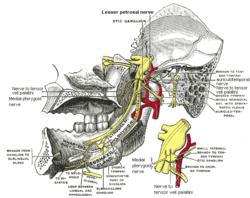Mylohyoid nerve
| Mylohyoid nerve | |
|---|---|
 Mandibular division of the trigeminal nerve. (Label for mylohyoid nerve is at bottom center.) | |
 Mandibular division of trifacial nerve, seen from the middle line. The small figure is an enlarged view of the otic ganglion. (Label "to mylohyoid" at bottom left.) | |
| Details | |
| From | inferior alveolar nerve |
| Innervates | mylohyoid muscle, anterior belly of digastric muscle |
| Identifiers | |
| Latin | nervus mylohyoideus |
| TA98 | A14.2.01.090 |
| TA2 | 6275 |
| FMA | 53247 |
| Anatomical terms of neuroanatomy | |
The mylohyoid nerve (or nerve to mylohyoid) is a nerve of the head. It is a branch of the inferior alveolar nerve. It supplies the mylohyoid muscle, and the anterior belly of the digastric muscle. It may also supply mandibular (lower) molar teeth, requiring local anaesthesia for some oral procedures.
Structure[]
The mylohyoid nerve is a branch of the inferior alveolar nerve, a branch of the mandibular nerve (CN V3), itself a branch of the trigeminal nerve (CN V).[1][2] It contains both motor neurons and sensory neurons.[2] It branches just before it enters the mandibular foramen .[2] It descends in a groove on the deep surface of the ramus of the mandible.[2] When it reaches the under surface of the mylohyoid muscle, it gives branches to both the mylohyoid muscle and the anterior belly of the digastric muscle.[2]
Function[]
The mylohyoid nerve supplies the mylohyoid muscle and the anterior belly of the digastric muscle.[1][2] It may also give some sensory supply to the mandibular (lower) molar teeth.[3]
Clinical significance[]
The mylohyoid nerve needs to be blocked during local anaesthesia of the mandibular (lower) teeth to prevent pain during oral procedures.[3][4] It may not be anaesthetised during a block of the inferior alveolar nerve, causing pain.[2]
Additional images[]

Mandible of human embryo 24 mm. long. Outer aspect.

Mandible of human embryo 95 mm. long. Inner aspect. Nuclei of cartilage stippled.
Infratemporal fossa. Lingual and inferior alveolar nerve. Deep dissection. Anterolateral view
References[]
![]() This article incorporates text in the public domain from page 896 of the 20th edition of Gray's Anatomy (1918)
This article incorporates text in the public domain from page 896 of the 20th edition of Gray's Anatomy (1918)
- ^ a b Hallinan, James T. P. D.; Sia, David S. Y.; Yong, Clement; Chong, Vincent (2018). "Chapter 3 - The Sphenoid Bone". Skull Base Imaging. Elsevier. pp. 39–64. doi:10.1016/B978-0-323-48563-0.00003-9. ISBN 978-0-323-48563-0.
- ^ a b c d e f g Bennett, Sam; Townsend, Grant (2001). "Distribution Of The Mylohyoid Nerve: Anatomical Variability And Clinical Implications". Australian Endodontic Journal. 27 (3): 109–111. doi:10.1111/j.1747-4477.2001.tb00470.x. ISSN 1747-4477.
- ^ a b Ferneini, Elie M.; Bennett, Jeffrey D. (2016). "32 - Anesthetic Considerations in Head, Neck, and Orofacial Infections". Head, Neck, and Orofacial Infections - A Multidisciplinary Approach. Elsevier Science. pp. 422–437. doi:10.1016/B978-0-323-28945-0.00032-6. ISBN 978-0-323-28945-0.
- ^ Gulabivala, K.; Ng, Y.-L. (2014). "10 - Management of acute emergencies and traumatic dental injuries". Endodontics (4th ed.). Mosby. pp. 264–284. doi:10.1016/B978-0-7020-3155-7.00010-2. ISBN 978-0-7020-3155-7.
External links[]
- Anatomy photo:27:09-0102 at the SUNY Downstate Medical Center - "Infratemporal Fossa: The Inferior Alveolar Nerve and the Vessels"
- MedEd at Loyola GrossAnatomy/h_n/cn/cn1/cnb3.htm
- lesson4 at The Anatomy Lesson by Wesley Norman (Georgetown University) (mandibularnerve)
- cranialnerves at The Anatomy Lesson by Wesley Norman (Georgetown University) (V)
- Wikipedia articles incorporating text from the 20th edition of Gray's Anatomy (1918)
- Nerves


